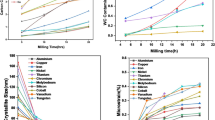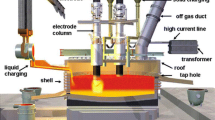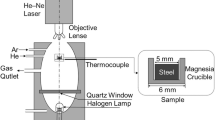Abstract
The growth of scales on impure Ni at 1373 and 1473 K was examined by microscopy and by oxygen-tracer-imaging techniques. The outward transport of cations was the basic rate-controlling step, and on the simple initial columnar scales such cation movement was the only kinetic process. However, oxygen movement was essential for the continued growth of more complex scales. Three types of sub columnar oxide were observed: (1) relatively coarse equiaxed crystals, (2) fume-like crystals, and (3) oxide that filled the pores between the crystals of the first two types. The oxygen for the first two types was provided by dissociation of the base of the columnar layer and also from voids that developed in the columnar layer. Oxygen for the third type came directly from the atmosphere following scale cracking. Such cracks healed after forming. The origin of the major features of scales was accounted for.
Similar content being viewed by others
References
K. Fueki and J. B. Wagner, Studies of the oxidation of nickel in the temperature range of 900–1400‡C,J. Electrochem. Soc. 112, 384–388 (1965).
W. W. Smeltzer and D. J. Young, Oxidation properties of transition metals.Prog. Solid State Chem. 10, 17–54 (1975).
P. Kofstad, Oxidation mechanisms for pure metals in single oxidant metals, inHigh Temperature Corrosion, R. A. Rapp, ed. (NACE, Houston, Texas, 1983), pp. 123–138.
F. A. Elfrefaie, A. Manolescu, and W. W. Smeltzer, Oxidation properties of Ni in the temperature range 1073–1500 K,J. Electrochem. Soc. 132, 2489–2493 (1985).
A. Atkinson, Transport processes during the growth of oxide films at elevated temperatures,Rev. Mod. Phys. 57, 437–470 (1985).
C. Wagner, Diffusion and high temperature oxidation of metals, inAtom Movements (ASM, Cleveland Ohio, 1951), pp. 153–173.
A. Atkinson, R. I. Taylor, and A. E. Hughes,Phil. Mag. 45, 823 (1982).
F. N. Rhines, R. G. Connell, Jr., and M. S. Choi, Microstructural evolution of the inner layer of the high temperature oxide scale on nickel,J. Electrochem. Soc. 126, 1061–1066 (1979).
Y. Y. Liu and K. Natesan, The adherence of nickel oxide on nickel during high-temperature oxidation, inMaterials Research Soc. Symp. Proc, Vol. 119, Adhesion in Solids, D. M. Mattoxet al., eds. (Reno, Nevada, 1980), pp. 213–221.
S. Mrowec, On the mechanism of high temperature oxidation of metals and alloys,Corros. Sci. 7, 563–578 (1967).
P. Kofstad, On the formation of porosity and microchannels in oxides,Oxid. Met. 24, 265–276 (1985).
G. Gibbs and R. Hales, The influence of metal lattice vacancies on the oxidation of high temperature materials,Corros. Sci. 17, 487–507 (1977).
J. Robertson and M. I. Manning, Criteria for formation of single layer, duplex, and breakaway scales on steels,Mater. Sci. Technol. 4, 1064–1071 (1988).
A. Atkinson and D. W. Smart, Transport of nickel and oxygen during the oxidation of nickel and dilute nickel/chromium alloy,J. Electrochem. Soc. 135, 2886–2893 (1988).
A. W. Harris and A. Atkinson, Oxygen transport in growing nickel oxide scales at 600–800‡C,Oxid. Met. 34, 229–258 (1990).
J. S. Sheasby and B. Gleeson, Oxygen tracer study of the high temperature oxidation of cobalt,Oxid. Met. 32, 379–390 (1989).
J. S. Sheasby, D. S. Cox, B. Gleeson, and H. L. Williams, Evolution of the structure of NiO and CoO scales, inProceedings of the Symposium on High Temperature Oxidation and Sulfidation Reactions, Vol. 22, J. D. Embury, ed. (The Metallurgical Society of the Canadian Institute of Mining and Metallurgy, Embury, Hamilton, Ontario, August 1990), pp. 16–27.
M. J. Graham and D. Caplan, Detection of CO in cavities in NiO scales,J. Electrochem. Soc. 120, 769–770 (1973).
Author information
Authors and Affiliations
Rights and permissions
About this article
Cite this article
Sheasby, J.S., Cox, D.S. Scale development on impure nickel at high temperatures. Oxid Met 37, 373–387 (1992). https://doi.org/10.1007/BF00666626
Received:
Revised:
Issue Date:
DOI: https://doi.org/10.1007/BF00666626




